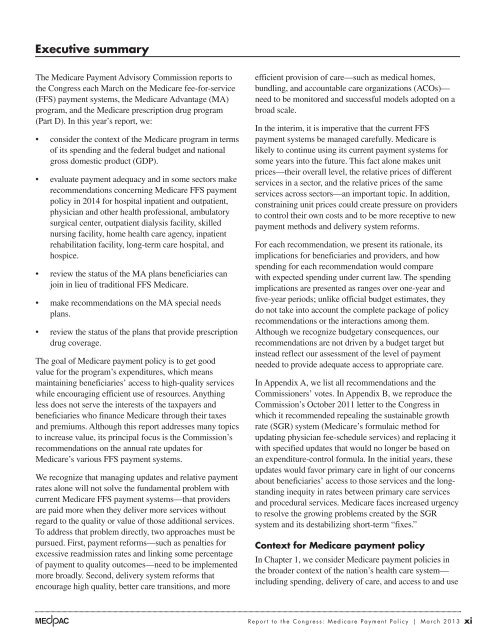Medicare Payment Policy
Medicare Payment Policy
Medicare Payment Policy
You also want an ePaper? Increase the reach of your titles
YUMPU automatically turns print PDFs into web optimized ePapers that Google loves.
executive summary<br />
The <strong>Medicare</strong> <strong>Payment</strong> Advisory Commission reports to<br />
the Congress each March on the <strong>Medicare</strong> fee-for-service<br />
(FFS) payment systems, the <strong>Medicare</strong> Advantage (MA)<br />
program, and the <strong>Medicare</strong> prescription drug program<br />
(Part D). In this year’s report, we:<br />
• consider the context of the <strong>Medicare</strong> program in terms<br />
of its spending and the federal budget and national<br />
gross domestic product (GDP).<br />
• evaluate payment adequacy and in some sectors make<br />
recommendations concerning <strong>Medicare</strong> FFS payment<br />
policy in 2014 for hospital inpatient and outpatient,<br />
physician and other health professional, ambulatory<br />
surgical center, outpatient dialysis facility, skilled<br />
nursing facility, home health care agency, inpatient<br />
rehabilitation facility, long-term care hospital, and<br />
hospice.<br />
• review the status of the MA plans beneficiaries can<br />
join in lieu of traditional FFS <strong>Medicare</strong>.<br />
• make recommendations on the MA special needs<br />
plans.<br />
• review the status of the plans that provide prescription<br />
drug coverage.<br />
The goal of <strong>Medicare</strong> payment policy is to get good<br />
value for the program’s expenditures, which means<br />
maintaining beneficiaries’ access to high-quality services<br />
while encouraging efficient use of resources. Anything<br />
less does not serve the interests of the taxpayers and<br />
beneficiaries who finance <strong>Medicare</strong> through their taxes<br />
and premiums. Although this report addresses many topics<br />
to increase value, its principal focus is the Commission’s<br />
recommendations on the annual rate updates for<br />
<strong>Medicare</strong>’s various FFS payment systems.<br />
We recognize that managing updates and relative payment<br />
rates alone will not solve the fundamental problem with<br />
current <strong>Medicare</strong> FFS payment systems—that providers<br />
are paid more when they deliver more services without<br />
regard to the quality or value of those additional services.<br />
To address that problem directly, two approaches must be<br />
pursued. First, payment reforms—such as penalties for<br />
excessive readmission rates and linking some percentage<br />
of payment to quality outcomes—need to be implemented<br />
more broadly. Second, delivery system reforms that<br />
encourage high quality, better care transitions, and more<br />
efficient provision of care—such as medical homes,<br />
bundling, and accountable care organizations (ACOs)—<br />
need to be monitored and successful models adopted on a<br />
broad scale.<br />
In the interim, it is imperative that the current FFS<br />
payment systems be managed carefully. <strong>Medicare</strong> is<br />
likely to continue using its current payment systems for<br />
some years into the future. This fact alone makes unit<br />
prices—their overall level, the relative prices of different<br />
services in a sector, and the relative prices of the same<br />
services across sectors—an important topic. In addition,<br />
constraining unit prices could create pressure on providers<br />
to control their own costs and to be more receptive to new<br />
payment methods and delivery system reforms.<br />
For each recommendation, we present its rationale, its<br />
implications for beneficiaries and providers, and how<br />
spending for each recommendation would compare<br />
with expected spending under current law. The spending<br />
implications are presented as ranges over one-year and<br />
five-year periods; unlike official budget estimates, they<br />
do not take into account the complete package of policy<br />
recommendations or the interactions among them.<br />
Although we recognize budgetary consequences, our<br />
recommendations are not driven by a budget target but<br />
instead reflect our assessment of the level of payment<br />
needed to provide adequate access to appropriate care.<br />
In Appendix A, we list all recommendations and the<br />
Commissioners’ votes. In Appendix B, we reproduce the<br />
Commission’s October 2011 letter to the Congress in<br />
which it recommended repealing the sustainable growth<br />
rate (SGR) system (<strong>Medicare</strong>’s formulaic method for<br />
updating physician fee-schedule services) and replacing it<br />
with specified updates that would no longer be based on<br />
an expenditure-control formula. In the initial years, these<br />
updates would favor primary care in light of our concerns<br />
about beneficiaries’ access to those services and the longstanding<br />
inequity in rates between primary care services<br />
and procedural services. <strong>Medicare</strong> faces increased urgency<br />
to resolve the growing problems created by the SGR<br />
system and its destabilizing short-term “fixes.”<br />
Context for <strong>Medicare</strong> payment policy<br />
In Chapter 1, we consider <strong>Medicare</strong> payment policies in<br />
the broader context of the nation’s health care system—<br />
including spending, delivery of care, and access to and use<br />
Report to the Congress: <strong>Medicare</strong> <strong>Payment</strong> <strong>Policy</strong> | March 2013<br />
xi


